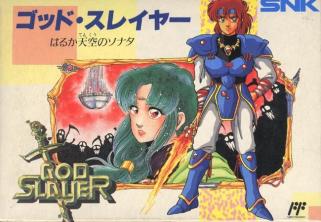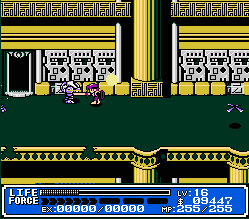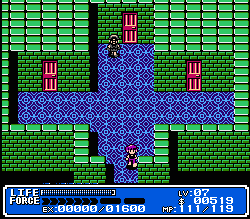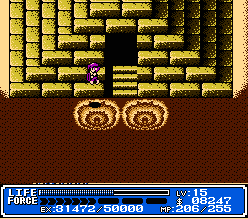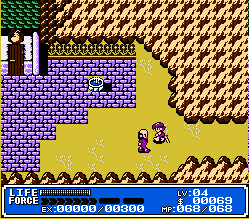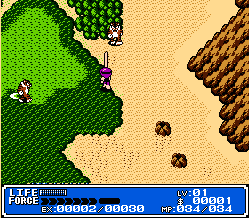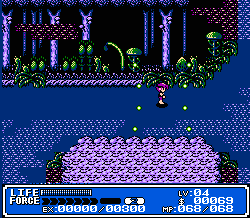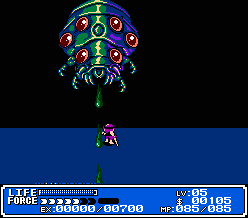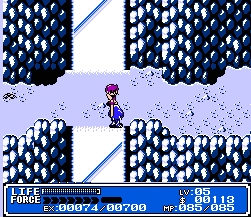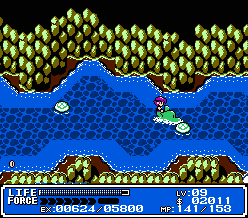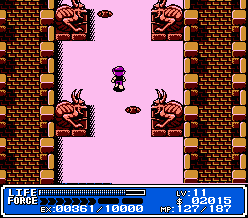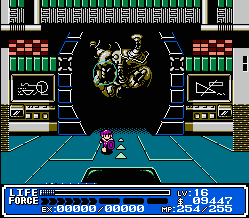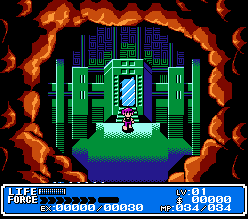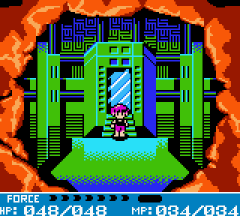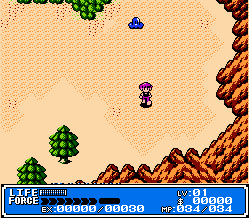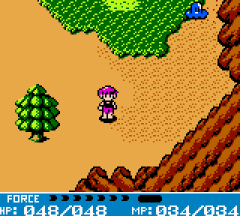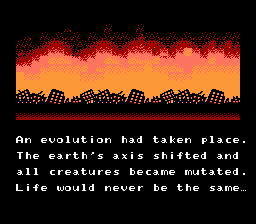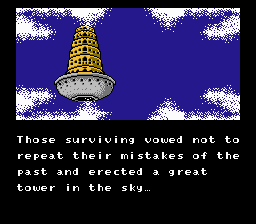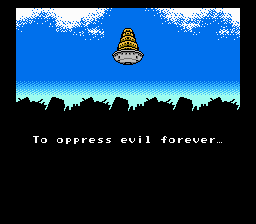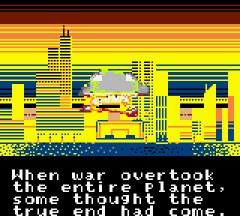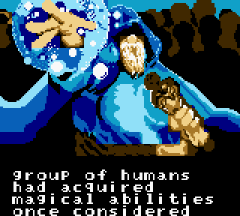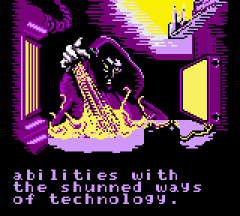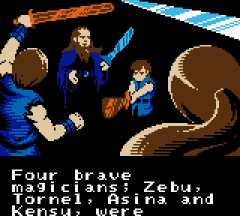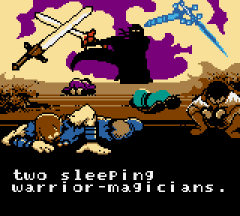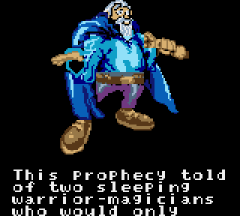
Known in Japan as Godslayer: Sonata of the Far Away Skies, Crystalis was developed by SNK. The game was essentially a Zelda clone for the NES, but it expounded so much on Nintendo's formula that oftentimes, it's even better. As a result, Crystalis is remembered as one of the best early action-RPGs, surpassing almost all contenders in the field in terms of overall gameplay, and even earning a spot in Nintendo Power's top 100 games in the magazine's 100th issue.
In the distant and far off year of 1997 (which was somewhat distant when this game was released back in 1990), war has engulfed the world, tilting the planet on its axis, and causing horrible mutations. Naturally, all of this chaos results in the near extinction of humanity. The survivors build a tower in the sky with enough firepower to rule - or even destroy - the world as a safe guard against future cataclysms.
After the prologue of Crystalis finishes, the first thing you see is a computer booting up, which then asks your name. You step out of cryogenic sleep, and find out that 100 years have passed. Humanity is back on its feet, although most aspects of technology have been abandoned in favor of magic. But there's still trouble afoot. The evil Draygonia Empire is trying to seize this tower for their own ends, and only you can find the four elemental swords necessary to create the legendary weapon dubbed Crystalis. Through the game you learn more about yourself, the tower, and the ambitions of the Empire and those fighting against it, in a surprisingly well developed story, especially when console RPG storytelling was in its infancy. Along the way, you'll meet a girl named Mesia, who was also set into cryo-stasis around the same time as you. As a result, she is also desired by the evil Emperor Draygon. You'll also make friends with a hero named Stom and a wise man named Azteca. The game features eleven towns, five swords, eight magic spells, and a wide bestiary of foes and vast mazes to navigate.
Unlike The Legend of Zelda, your character gains levels by beating up bad guys. Your character starts out at level 1, equipped with the Sword of Wind. Along the way, you'll find more swords with different powers. These elemental swords can be charged up by holding down the B button to fire out special blasts. Up to 3 levels of power for each sword can be reached with the proper items. Each of the swords can be used to conquer various obstacles, such as blowing away barriers or freezing rivers. You can gain up to 16 levels of experience (along with the traditional 255 HP and MP, and 65535 gold). Leveling up comes easily enough, though you will probably want to spend a little bit of time level grinding to make sure you're prepared.
Crystalis
The eight spells include two heal spells to cure damage and status, a teleport spell, and utility spells which allow you to stun enemies and even townsmen when needed, You can also change your shape (which is very fun to do), telepathically communicate with the four wise men who are your guides, create a barrier to stop damage, and call upon invisible wings to help you float over pits and other dangerous obstacles. Spells are obtained at certain benchmarks in the game, but they consume MP when used. You have to be careful when balancing it, because the strongest sword attacks also drain MP.
There's also your standard arsenal of sundry shields, armor and medical herbs. You can also obtain a pair of warp boots for travel between towns, and the all mighty "opal statue" which acts as a automatic revival device for the unfortunate hero that runs out of HP. Also there are various flutes, masks, boots, and rings to use and equip to increase your stats, find hidden passages, climb icy slopes, and even navigate poison marshes. Prices on weapons, armor, and items usually inflate as you progress through the game, and some items can only be purchased in certain towns at certain times.
Crystalis
The game starts out fairly linear, but you can explore more as you progress. Towns and the people that inhabit them start to change in the end, and new areas crop up that you aren't guided to, but hold crucial items for you to succeed. The only time you really can't go back to a previous area is after you enter the final, final dungeon. There really aren't any Zelda-style puzzles, but finding all of the necessary items requires some exploration. Thankfully, the telepathy spell usually points you in the right direction, so you shouldn't have too hard a time. The gameplay is fluid and the controls are solid. Your hero runs fast and attacks quickly, giving the game a much faster pace than your usual RPG. The only quirk is that you need to stand still in order to charge your swords. It can be a bit annoying to switch between your elemental swords, since certain enemies can't be damaged by certain swords. Normal enemies can swarm you and deal a fair amount of damage, and when you get hit by a group of enemies vulnerable to different swords, you need to improvise (a ping sound means no damage is being dealt - either due to being underleveled or by elemental immunity,) The game can be challenging, especially for a first time player, as both with normal enemies and the bosses can be challenging. Bosses present a tricky scenario as most of them are immune to all but one of the four elements (thankfully, unless you cheat, you can't fight a boss who is immune to your current weapons set). Although you spend most of the game, running around, stabbing and shooting enemies, there is one cool area where you ride on the back of a dolphin, one of my favorite parts of Crystalis.
The music is pretty catchy - the songs from the mountains, Shryron Town, the ocean, and the pyramids are some of the standouts. The graphics are colorful, although there's plenty of palette swapping for both enemies and levels. The pink haired hero might seem a little garish, and the different areas run through a gamut of different colors, but it's never bland. Some of the designs seem inspired by Hayao Miyazaki's Nausicäa, especially one of the insect bosses which looks exactly like one of the Ohmu.
Crystalis
Although Crystalis found plenty of fans amongst dedicated NES gamers, it never quite reached the same success as other Nintendo franchises. SNK never saw it fit to make a sequel, It's strange how they'll stick characters from crap like Psycho Solider and Athena into The King of Fighters games, but completely ignore anything from Crystalis (Athena and Kensou do make cameo appearances as one of the four warriors in Crystalis, although their names are translated as "Asina" and "Kensu".) However, Crystalis must have had plenty of fans working for Nintendo, who produced a port to the Game Boy Color in 2000.
This port was done by Nintendo Software Technology ("NST"), an American studio which also made Bionic Commando: Elite Forces. Although it's obvious that the team had great respect for the original, they didn't quite handle it properly, so many fans of the original considered this a downgrade. The biggest difference is the change in resolution - the screen is much smaller, so your viewpoint is often cramped. The music is completely different, and far worse. There are new cutscenes in the intro and ending, but the art is questionable. Arguably the biggest sin is that they butchered the one unique and surprising plot element of the original game that set it apart from most other RPGs of the day.
Both versions are set in a post apocalyptic future where magic has emerged to replace technology. In the NES version, the tower was an ancient weapon used to judge humanity to see whether it progressed beyond the wars that destroyed it in ages past. Mesia and the hero were scientists who had helped design the tower before being put in stasis, and were charged to make the final decision as to whether or not it should be used, based on how humanity has grown since the last disaster. Naturally the Empire wants it for its own purposes of world domination, making it a race to get control of the tower.
Instead, in the GBC version, the tower was turned into a mere Draygonian super weapon, opting instead for a more neo-luddite magic-using rebels vs. an evil technologically based empire theme like most other clichéd RPG plots out there. The hero and Mesia end up being "warrior-magicians" of prophecy set to fight the Empire's deadly combination of magic and "forbidden technology" to restore hope for the future of a cleaner, friendlier, magic using world.
Not all of the changes are bad. Enemies are no longer immune to different swords, so there's no need to constantly switch between them. There are also a few new items, retranslated names, and a completely new extra dungeon at the end, expanding upon the final tower's layout. The final level is now more of a maze than a series of fights. It swaps the order of some of the bosses (only the last couple - the tower's central CPU, originally the final boss, was made the penultimate boss in place of the Emperor who is now the end boss). Nintendo insisted this was because SNK hadn't finished the original game, and Nintendo was merely fleshed it out, completing its vision.
In the end, both versions of Crystalis are worth a try, even though the NES version is more satisfying in terms of story, and I'd imagine, for one's overall gaming experience.
Links:
Game Club 199X Episode 11 Our podcast about the experience of playing Crystalis.
Tom's Crystalis World A shrine to the game.
1up - Console vs Handheld A comparison between both versions.
Gamespite - Crystalis More critical differences between the NES and GBC versions.
Quick Info:
|
Developer: |
|
|
Publisher: |
|
|
Director (NES): |
|
|
Director (GBC): |
|
|
Genre: |
|
|
Themes: |
Crystalis (NES)
Crystalis (NES)
Crystalis (NES)
Crystalis (NES)
Crystalis (NES)
Crystalis (NES)
Crystalis (NES)
Crystalis (NES)

